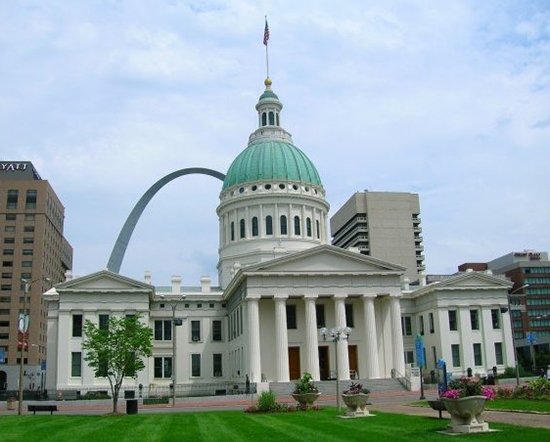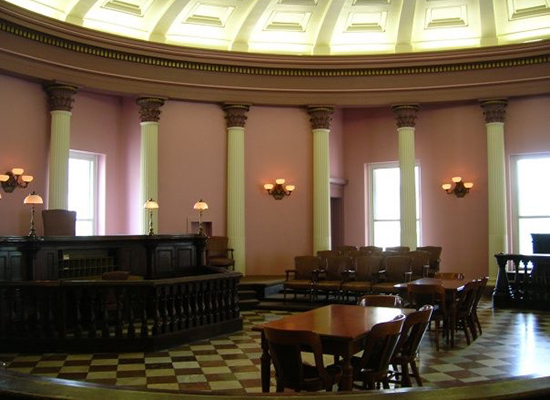
The Old Courthouse in downtown St. Louis, Missouri, sits just west of the Gateway Arch, and only a few blocks north of Busch Stadium, home of the St. Louis Cardinals. It is the home of several hearings that led to the Dred Scott Decision and other historic cases in Missouri's rich legal history.
To prepare for the construction of the Jefferson National Expansion Memorial, which is more commonly referred to as the Arch, over 80 acres of prime riverfront real estate in downtown St. Louis were condemned, and the structures located there leveled. One of the few buildings spared was the Old Courthouse.
Mistakenly referred to as the old state capitol by many a sports broadcaster when their camera crew is showing shots of the city, the Old Courthouse has a rich history. It is best known as the site of the original Dred Scott case, but it was also the site of slave auctions and an important voting rights case.
The Old Courthouse opened in 1828 as a joint city, state, and federal courthouse. It was one of the first public buildings west of the Mississippi. The original building was added on to and remodeled over the years, but the National Park Service suggests the exterior looks mostly as it did in the 1840-50s, when the original Dred Scott cases were heard. Since 1930, the building has not been used as a courthouse.
Dred Scott Decision and the Old Courthouse
Dred and Harriet Scott sued for their freedom after living with their owner in the Territory of Wisconsin. They argued that they could no longer be enslaved because they had lived a significant period of time in a free area. At the time, Missouri courts were applying a rule referred to as “once free, always free,” so this was not a novel argument.
The first trial was a mistrial, but the second trial, heard in the Old Courthouse, granted the Scotts their freedom. That decision was appealed to the Supreme Court of Missouri, which overturned earlier “once free, always free” precedent and held that the Scotts must remain enslaved.
Dred and Harriet then filed another lawsuit, this time in federal court. That case that went all the way up to the United States Supreme Court and remains a painful reminder of our nation’s pro-slavery history.

You can visit the courtroom where the Dred Scott case was heard, and where Dred Scott and his wife Harriet were ultimately granted freedom. It has been restored to resemble what it may have looked like in the 1850s.
The Restored Courtroom
The courtroom where the state court cases were heard has been restored to look like what it may have looked like in the 1840-50s. Interestingly enough, that courtroom is also where the Scotts got their freedom despite the Supreme Court’s ruling. The owner who had fought to keep them enslaved passed away, and the Scotts were sold to another owner, who freed them.
See video from C-SPAN in 2014 to hear an interview with a park ranger and see views of both interior and exterior of the Old Courthouse.
Something I didn’t realize before touring the courthouse was how common cases like Dred and Harriet Scott’s case were. According to the Missouri Historical Society, Missouri courts heard a significant number of cases where slaves sued their masters for their right to freedom under the “once free, always free” doctrine.
When you take a guided tour of the courthouse, you may hear about slave auctions that occurred on the courthouse steps. It is upsetting to stand where other people were once bought and sold, but it is an important reminder of how commonplace such horrific acts once were. Estates were probated in the courthouse, and “property” was auctioned off to new owners just outside the front door for convenience sake. See the Missouri Historical Society video that tells the story of one of the last slave auctions at the courthouse.
Minor v. Happersett: Women’s Right to Vote
The other court case often associated with the Old Courthouse is Minor v. Happersett.
Virginia Minor was an officer in the National Woman Suffrage Association. She and other advocates for women’s suffrage believed that the 14th Amendment gave them the right to vote, and all they needed to do was exercise it.
Minor attempted to register to vote in the 1872 presidential election, but was turned away. Her husband sued on her behalf (women weren’t allowed to bring lawsuits in Missouri court at that time), and the case went all the way up to the U.S. Supreme Court, which ruled against Minor. Following the decision, the suffrage movement focused their efforts on making changes to voting laws state by state instead of seeking recognition of the right to vote in federal court.
The fact that both of the major cases tried at the Old Courthouse center around fundamental questions of what it means to be a citizen is fitting. The Gateway Arch National Park celebrates not just the westward migration of people, but the expansion of America as a country, and the growth of the American identity. The Old Courthouse tells an important part of this story, and it is well worth a visit if you are in the St. Louis area.
While You Are in Town
While you are in St. Louis, check out these other interesting locations:
The Thomas F. Eagleton U.S. Courthouse is just a few blocks away from the Old Courthouse. It has interesting public displays on the judicial system, and the top floor provides sweeping views of downtown St. Louis.
Steps away from the Eagleton Courthouse is Busch Stadium, home of this lawyer’s favorite baseball team. There are artifacts from the Flood v. Kuhn case on free agency in the Cardinals Hall of Fame and Museum.
The former headquarters of the International Shoe Company, yes that International Shoe, is now home to City Museum. City Museum is part architectural museum and part jungle gym. It is not something that can be easily described – you need to experience it for yourself.
Across the river in Illinois is what is known as America’s forgotten city or America’s Egypt – Cahokia. Cahokia Mounds was once the largest Native American city north of Mexico, and at its center is a 10-story tall earthen mound. The first white person to explore and describe this UNESCO World Heritage Site to the general public was a lawyer.
This article is part of a series of blog posts on legal tourist destinations that members of the Nonresident Lawyers Division have visited. If you would like to contribute an article, please reach out to Emily Kelchen, the head of the NRLD’s communications committee.
